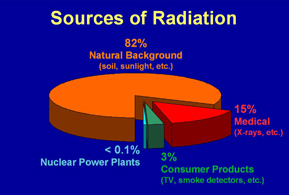Radiation is a safe part of everyday life
Radiation occurs naturally in the environment and is a by-product of many industrial activities, including nuclear power production. Scientists have studied the effects of radiation for more than 100 years, providing a solid basis for regulations to protect nuclear workers and the public.
At FPL, we don't just meet government standards for radiation protection; we go beyond them.
To ensure that we are meeting all of our commitments, we maintain a comprehensive radiation-monitoring program covering the regions around our plants. This program includes taking frequent samples of:
- Air
- Water
- Vegetation
- Fish
- Soil
The program is operated by well-trained and highly experienced radiological experts at the site, and the readings are independently verified by state and federal officials. Even the slightest increase in radiation levels at our plants would be detected and reported immediately.
FPL's radiation-monitoring program consistently shows that our facilities are well below the very conservative radiation exposure limits established by the U.S. Environmental Protection Agency (EPA) and U.S. Nuclear Regulatory Commission (NRC). And multiple public health studies by groups including the National Cancer Institute and National Academy of Sciences have shown no adverse health effects associated with the operation of nuclear power plants.
Natural radiation
Radiation is found widely in the natural environment and comes from sources such as the sun, outer space, and radioactive elements in soil, food, and water. Radiation is measured in units called rem and millirem (one rem equals 1,000 millirem). Most people routinely receive an average of about 500 millirem of radiation a year from all sources. In fact, according to the National Council on Radiation Protection and Measurements, about 82 percent of an individual's exposure to radiation comes from natural sources.

Manmade radiation
Ionizing radiation, in which electrons are removed from atoms, causing the atoms to become electrically charged ions, results from activities such as X-rays and other medical procedures, as well as nuclear power plant operations. Non-ionizing radiation, in which electrons are not removed from atoms, result from activities such as using radar, lasers and microwave ovens.
According to the National Council on Radiation Protection and Measurements, the following consumer products account for three times as much radiation exposure in the United States as the nuclear industry:
- Television sets
- Building materials
- Smoke alarms
- Natural gas
- Tobacco
- Luminous dials on watches and clocks